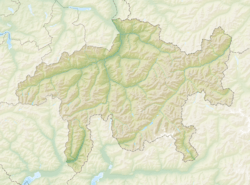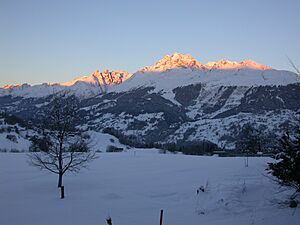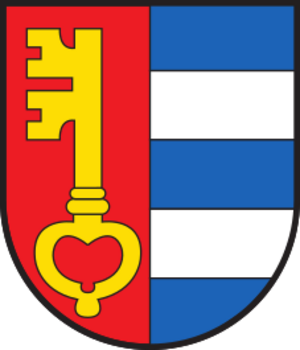Obersaxen facts for kids
Quick facts for kids
Obersaxen
|
||
|---|---|---|
 |
||
|
||
| Country | Switzerland | |
| Canton | Graubünden | |
| District | Surselva | |
| Area | ||
| • Total | 61.52 km2 (23.75 sq mi) | |
| Elevation
(Meierhof)
|
1,281 m (4,203 ft) | |
| Population
(Dec 2020 )
|
||
| • Total | 829 | |
| • Density | 13.475/km2 (34.901/sq mi) | |
| Postal code |
7134
|
|
| Localities | Obersaxen, Meierhof | |
| Surrounded by | Breil/Brigels, Degen, Flond, Lumbrein, Rueun, Sumvitg, Surcuolm, Trun, Vella, Vignogn, Waltensburg/Vuorz | |
Obersaxen (called Sursaissa in Romansh) was once a municipality in the Surselva district of the Swiss canton of Graubünden. On January 1, 2016, Obersaxen joined with the nearby municipality of Mundaun. Together, they formed the new municipality of Obersaxen Mundaun.
Contents
History of Obersaxen
Obersaxen was first mentioned in old writings around the year 765. Back then, it was known as Supersaxa. Later, in 1227, it was called Ubersahse.
The Walser People Arrive
The area we know today as Obersaxen was settled in the 1200s. A group of German-speaking people called the Walser moved here. They came from a different part of Switzerland.
This is interesting because Obersaxen is in the Surselva valley. Most people in Surselva speak Romansh, which is another Swiss language. So, Obersaxen became like a small island where people spoke German. They spoke a special kind of Swiss German.
Geography of Obersaxen
Obersaxen covers an area of about 61.5 square kilometers (23.7 square miles). A large part of this land, about 54.8%, is used for farming. Forests cover about 23.4% of the area.
Land Use and Settlements
Only a small part of the land, about 2%, has buildings or roads. The rest, about 19.8%, is made up of rivers, glaciers, or mountains. These parts are not used for farming or building.
Obersaxen is located on the northern side of the Mundaun mountain range. It sits on the right side of the Rhine valley. The area has 28 smaller villages or settlements. These are grouped into five main areas called Pirten. The main village in the center is called Meierhof.
Obersaxen's Coat of Arms
The coat of arms for Obersaxen has two main parts. The right side shows a golden key on a red background. This key is a symbol of Saint Peter. It was also on the village's old seal from the 1300s.
The left side of the coat of arms has two silver bars on a blue background. This part comes from the seal of the Freiherr of Rhäzüns. The Freiherr was a noble family who gained rights in Obersaxen because of the Walser people settling there.
People and Population
Obersaxen had a population of 838 people in 2014. About 6.6% of the people living there in 2008 were from other countries. Over the last 10 years, the number of people living in Obersaxen has gone down a little.
Languages Spoken
Most people in Obersaxen speak German. In 2000, about 89.3% of the population spoke German. The second most common language was Romansh, spoken by 5.0% of people. Portuguese was the third most common, spoken by 3.7%.
Age Groups
In 2000, the population of Obersaxen was almost evenly split between males and females. About 49.3% were male and 50.7% were female.
Here's a look at the different age groups:
- Children (0-9 years old): 11.3% of the population.
- Teenagers (10-19 years old): 13.9% of the population.
- Young adults (20-29 years old): 8.3% of the population.
- Adults (30-39 years old): 16.7% of the population.
- Adults (40-49 years old): 16.8% of the population.
- Adults (50-59 years old): 11.8% of the population.
- Seniors (60-69 years old): 9.0% of the population.
- Seniors (70-79 years old): 8.0% of the population.
- Seniors (80-89 years old): 4.0% of the population.
- Seniors (90-99 years old): 0.3% of the population.
Education and Jobs
Many adults in Obersaxen have a good education. About 64.9% of people aged 25-64 have finished high school or gone on to higher education, like university.
The unemployment rate in Obersaxen is very low, at only 0.71%. This means almost everyone who wants a job has one.
In 2005, many people worked in different types of jobs:
- Primary sector: 98 people worked in jobs like farming. There were 47 businesses in this area.
- Secondary sector: 81 people worked in jobs like manufacturing or construction. There were 11 businesses in this area.
- Tertiary sector: 171 people worked in jobs like services (tourism, shops, etc.). There were 42 businesses in this area.
Population Changes Over Time
The table below shows how the population of Obersaxen has changed over many years:
| Year | Population |
|---|---|
| 1850 | 830 |
| 1900 | 652 |
| 1910 | 636 |
| 1950 | 705 |
| 2000 | 779 |
Sports in Obersaxen
Obersaxen is known for being a good place for skiing. It's a fairly large ski resort, but it's not as famous as some others, like Flims-Laax. However, many local people and those who know the area well love to ski here. They enjoy the good quality of the skiing and that it's not usually as crowded as other big resorts.
Obersaxen is also the home of Carlo Janka. He is a famous alpine skier who won the World Cup and an Olympic medal in 2010.
Images for kids
See also
 In Spanish: Obersaxen para niños
In Spanish: Obersaxen para niños







